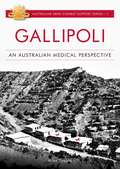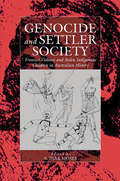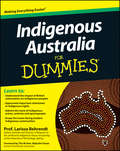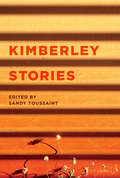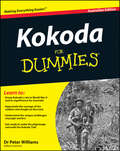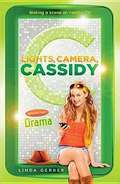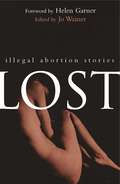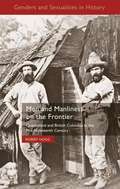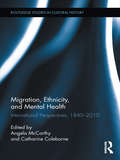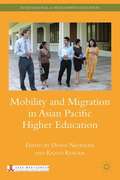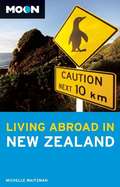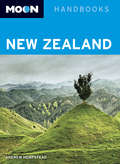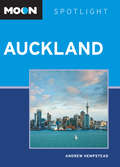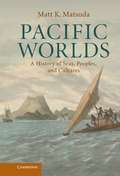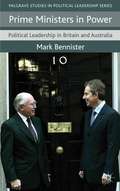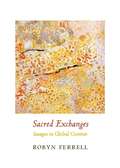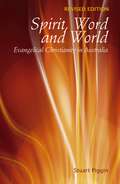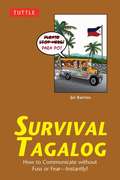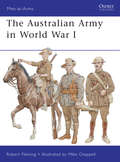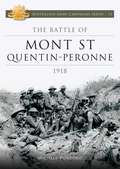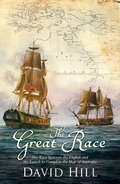- Table View
- List View
Gallipoli: An Australian Medical Perspective (Australian Combat Support #1)
by Michael TyquinTo be successful, a modern army needs logistical support to survive - to arm, feed, transport, and care for its soldiers. As history shows us the maintenance of health in any army , is a key factor in warfare. In many respects the Gallipoli campaign was a doomed undertaking. The seeds of ultimate defeat in December 1915 were the risks that attended a hugely ambitious, complex, and large-scale amphibious operation - the landings on well-defended shores on the Gallipoli peninsula, under cover of darkness. Communications at the time were primitive, while general staff officers had little understanding of their own army's medical assets or the needs of a large medical organisation. The Australian Army Medical Corps (AAMC) received aid from, and gave support to, all five forces at various times during 1915. Underlying the execution of the Dardanelles campaign were factors wholly outside the control of the Australian AMS. Undoubtedly tragic, and sometimes avoidable, errors were made at the highest level of command, with subsequent pressures on the AMS. An amphibious operation of this type and scale, however, was without parallel in modern military history, and mistakes were inevitable, as they are with any campaign of such complexity. Gallipoli: An Australian Medical Perspective explores these complexities and mistakes through the eyes of the infant Australian Army Medical Corps.
Genocide And Settler Society
by A. Dirk MosesColonial Genocide has been seen increasingly as a stepping-stone to the European genocides of the twentieth century, yet it remains an under-researched phenomenon. This volume reconstructs instances of Australian genocide and for the first time places them in a global context. Beginning with the arrival of the British in 1788 and extending to the 1960s, the authors identify the moments of radicalization and the escalation of British violence and ethnic engineering aimed at the Indigenous populations, while carefully distinguishing between local massacres, cultural genocide, and genocide itself. These essays reflect a growing concern with the nature of settler society in Australia and in particular with the fate of the tens of thousands of children who were forcibly taken away from their Aboriginal families by state agencies. Long considered a relatively peaceful settlement, Australian society contained many of the pathologies that led to the exterminatory and eugenic policies of twentieth century Europe.
Indigenous Australia for Dummies (For Dummies Ser.)
by Larissa BehrendtA comprehensive, relevant, and accessible look at all aspects of Indigenous Australian history and culture What is The Dreaming? How many different Indigenous tribes and languages once existed in Australia? What is the purpose of a corroboree? What effect do the events of the past have on Indigenous peoples today? Indigenous Australia For Dummies answers these questions and countless others about the oldest race on Earth. It explores Indigenous life in Australia before 1770, the impact of white settlement, the ongoing struggle by Aboriginal and Torres Strait Islander peoples to secure their human rights and equal treatment under the law, and much more. Celebrating the contributions of Indigenous people to contemporary Australian culture, the book explores Indigenous art, music, dance, literature, film, sport, and spirituality. It discusses the concept of modern Indigenous identity and examines the ongoing challenges facing Indigenous communities today, from health and housing to employment and education, land rights, and self-determination. Explores significant political moments—such as Paul Keating's Redfern Speech and Kevin Rudd's apology, and more Profiles celebrated people and organisations in a variety of fields, from Cathy Freeman to Albert Namatjira to the Bangarra Dance Theatre and the National Aboriginal Radio Service Challenges common stereotypes about Indigenous people and discusses current debates, such as a land rights and inequalities in health and education This book will enlighten readers of all backgrounds about the history, struggles and triumphs of the diverse, proud, and fascinating peoples that make up Australia's Indigenous communities. With a foreword by former PM Malcolm Fraser, Indigenous Australia For Dummies is a must-read account of Australia's first people. 'Indigenous Australia For Dummies is an important contribution to the broad debate and to a better understanding of our past history. Hopefully it will influence future events.'—Former Prime Minister Malcolm Fraser
Kimberley Stories
by Sandy ToussaintA journey of discovery into one of Australia’s most intriguing and exotic regions, the Kimberley, this anthology features both artwork and writing. It includes contributions from talents such as Kate Auty, Peter Bibby, Lesley Corbett, Steve Hawke, Donna Bing-Ying Mak, Stephen Scourfield, Pat Mmanjun Bananga Torres, and Jacqueline Wright, and will appeal to a wide range of readers—travelers, fans of indigenous works, and those interested in desert culture and landscape.
Kokoda Trail for Dummies
by Peter WilliamsEverything you need to know about the Kokoda Trail and its place in Australian history Interest in the Kokoda Trail is growing rapidly among many Australians, both for its attraction as a hiking destination and for its historical significance. Kokoda For Dummies offers a fast track tool for learning everything you need to know about this unique thoroughfare, in one concise volume. Part history book, part practical guide, Kokoda For Dummies is perfect both for those considering following our Diggers’ footsteps along ‘the track’ or armchair travellers who want to learn about its history. Covering the full history of the Kokoda Trail, from its beginnings as an overland mail route to the fierce battles between the Australians and the Japanese that took place along its length during World War II, the book also includes important information on walking the trail yourself. From the steps you need to take to get ready to what to bring, Kokoda For Dummies is the definitive resource for anyone looking for a comprehensive overview of this significant landmark. Focuses on walking the track as a pilgrimage and a history lesson for history buffs and hiking enthusiasts alike Covers the health and safety concerns involved with walking the track, including a basic Kokoda itinerary Contains eyewitness accounts of the Kokoda battles gleaned from interviews conducted with Australian and Japanese war veterans A comprehensive but accessible history of the Kokoda Trail and its significance to Australia, in one volume.
Lights, Camera, Cassidy: Drama
by Linda GerberCassidy Barnett is not your average twelve- (almost thirteen!-) year -old. While most other girls her age are worries about school and clothes and boys, Cass has spent most of her life traveling the world with her travel TV-show-host parents. She gets to visit fabulous places and loves connecting with people via her popular blog. But when the producers of the show decide that they want to feature Cass on camera, all of that starts to change. Now she's got to think about what she says, how she looks, and what the world is saying about her. Because like it or not, it's LIGHTS, CAMERA, CASSIDY! G'day, mates! In this fourth episode, Cassidy and the crew of When in Rome get a hearty dose of Australian hospitality when they head to Melbourne to film. But while Cass is starting to get used to her celebrity status, she's not sure she likes it when she realizes that most of the fans seem more interested in Logan than in her. At the same time, there seem to be a lot of technical glitches interfering with filming. What's going on? And can Cass get over her jealousy and help figure it out before it's too late?
Lost: Illegal Abortion Stories
by Jo Wainer'It is chastening to read these bald tales, shockingly direct and unvarnished. Each story contains matter enough for a novel. Each one is a window onto a larger life, a broader world: a tantalising view of endlessly unfolding complexities.'-Helen Garner Twenty years ago, Dr Bertram Wainer, the abortion reform doctor and campaigner, placed an advertisement in a newspaper asking women who had illegal abortions to come forward to tell their stories. Their personal testimonies and the accounts from doctors and nurses are published for the first time in this collection. Women had to draw on deep reservoirs of courage and determination faced with the fear of illegal abortion. This collection tells of some of those acts of courage and the difficulties society placed in women's way. Moving and candid, these stories uncover the hidden history of abortion in Australia.
Men and Manliness on the Frontier
by Robert HoggIn mid-nineteenth-century Britain, there existed a dominant discourse on what it meant to be a man -denoted by the term 'manliness'. Based on the sociological work of R. W. Connell and others who argue that gender is performative, Robert Hogg asks how British men performed manliness on the colonial frontiers of Queensland and British Columbia.
Migration, Ethnicity, and Mental Health: International Perspectives, 1840-2010 (Routledge Studies in Cultural History)
by Catharine Coleborne Angela McCarthyMost investigations of foreign-born migrants emphasize the successful adjustment and settlement of newcomers. Yet suicide, heavy drinking, violence, family separations, and domestic disharmony were but a few of the possible struggles experienced by those who relocated abroad in the nineteenth and twentieth centuries, and were among the chief reasons for committal to an asylum. Significant analysis of this problem, addressing the interconnected issues of migration, ethnicity, and insanity, has to date received little attention from the scholarly community. This international collection examines the difficulties that migrants faced in adjustment abroad, through a focus on migrants and mobile peoples, issues of ethnicity, and the impact of migration on the mental health of refugees. It further extends the migration paradigm beyond patients to incorporate the international exchange of medical ideas and institutional practices, and the recruitment of a medical workforce. These issues are explored through case studies which utilize different social and cultural historical methods, but with a shared twin purpose: to uncover the related histories of migration, ethnicity, and mental health, and to extend existing scholarly frameworks and findings in this under-developed field of inquiry.
Mobility And Migration In Asian Pacific Higher Education
by Deane E. Neubauer Kazuo KurodaThrough case studies in eight Asian countries, Europe, and the United States, this volume explores the range and consequences of increased mobility within Asia-Pacific higher education and the patterns of migration emerging for persons, ideas, institutions, and practices.
Moon Living Abroad in New Zealand
by Michelle WaitzmanMichelle Waltzman fell in love with New Zealand’s stunning landscapes and various outdoor activities on a backpacking trip in 1998, and has since moved to the country, recently obtaining permanent resident status. Michelle provides insight and first-hand advice on all that living in New Zealand has to offer. She outlines all the information needed in a smart, organized, and straightforward manner, making planning the move abroad manageable. Moon Living Abroad in New Zealandmakes the moving and transition process easy for businesspeople, students, teachers, retirees, and professionals. Moon Living Abroad in New Zealandis packed with essential information and must-have details on setting up daily life including obtaining visas, arranging finances, gaining employment, choosing schools, and finding health care. This relocation guide also includes practical advice on how to rent or buy a home for a variety of needs and budgets, whether it’s an apartment in cosmopolitan Wellington or a home in historic Christchurch. All Moon Living Abroad Guides include color photos, black and white photos, black and white illustrations, and maps.
Moon New Zealand
by Andrew HempsteadAustralia native, Andrew Hempstead, knows the best way to experience nearby New Zealand from kayaking through the Bay of Island and skiing in the Southern Alps to sampling a glass of vino at a local wine tasting. Andrew includes unique trip ideas such as Maori Culture and History and Tramping through New Zealand. Packed with information on dining, transportation, and accommodations, Moon New Zealand has lots of options for a range of travel budgets. Every Moon guidebook includes recommendations for must-see sights and many area, regional, and city-centred maps. Complete with details on enjoying the land with children, fine-dining in Auckland, and rafting near Queenstown, Moon New Zealand gives travellers the tools they need to create a more personal and memorable experience. With expert writers, first-rate strategic advice, and an essential dose of humour, Moon Handbooks are the cure for the common trip.
Moon Spotlight Auckland
by Andrew HempsteadMoon Spotlight Auckland is an 115-page compact guide covering the best of New Zealand's most populous city. Experienced Australian travel writer Andrew Hempstead offers his firsthand advice on must-see attractions, as well as maps with sightseeing highlights, so you can make the most of your time. This lightweight guide is packed with recommendations on entertainment, shopping, recreation, accommodations, food, and transportation, making navigating this beautiful city - and its scenic surroundings - uncomplicated and enjoyable.
Nationalism and Human Rights
by Grace ChengThis collection of essays offers a comprehensive discussion of the challenge of promoting human rights in the face of nationalism's persistence as an ideological and mobilizational force in politics.
Pacific Worlds: A History of Seas, Peoples, and Cultures
by Matt K. MatsudaAsia, the Pacific Islands and the coasts of the Americas have long been studied separately. This essential single-volume history of the Pacific traces the global interactions and remarkable peoples that have connected these regions with each other and with Europe and the Indian Ocean, for millennia. From ancient canoe navigators, monumental civilisations, pirates and seaborne empires, to the rise of nuclear testing and global warming, Matt Matsuda ranges across the frontiers of colonial history, anthropology and Pacific Rim economics and politics, piecing together a history of the region. The book identifies and draws together the defining threads and extraordinary personal narratives which have contributed to this history, showing how localised contacts and contests have often blossomed into global struggles over colonialism, tourism and the rise of Asian economies. Drawing on Asian, Oceanian, European, American, ancient and modern narratives, the author assembles a fascinating Pacific region from a truly global perspective.
Prime Ministers in Power
by Mark BennisterTony Blair and John Howard appear to be incongruous choices for comparative analysis. Howard was from the ideological right of Australian politics, with a leadership style based on experience and an uncharismatic, cautious, bureaucratic persona. Blair was the charismatic, new progressive centre-left leader with an emotional, thespian style, stressing vision and moral imperatives. Yet, it is possible to identify both personal and institutional similarities. This book argues that both leaders stretched the institutional resources available to them and enhanced their own personal capital. Over time, the political capital generated by each inevitably fell away to the extent that they both (although for contrasting reasons) left office in 2007. Prime Ministers in Powerinvestigates prime ministerial predominance in Britain and Australia. It is a timely addition to the scholarly material on political leadership, adding a comparative dimension by using case study analysis of two prime ministers in similar political systems. How did these two prime ministers establish such predominant positions? How far can prime ministers stretch the institutions within which they work and how much of an impact does the office-holder have on the office? What conclusions can be drawn from the comparison of the two prime ministers? What are the consequences and costs of such predominance? This book addresses these questions, offering a comparative perspective on the nature of prime ministerial leadership.
Sacred Exchanges: Images in Global Context (Columbia Themes in Philosophy, Social Criticism, and the Arts)
by Robyn FerrellAs the international art market globalizes the indigenous image, it changes its identity, status, value, and purpose in local and larger contexts. Focusing on a school of Australian Aboriginal painting that has become popular in the contemporary art world, Robyn Ferrell traces the influence of cultural exchanges on art, the self, and attitudes toward the other.Aboriginal acrylic painting, produced by indigenous women artists of the Australian Desert, bears a superficial resemblance to abstract expressionism and is often read as such by viewers. Yet to see this art only through a Western lens is to miss its unique ontology, logics of sensation, and rich politics and religion. Ferrell explores the culture that produces these paintings and connects its aesthetic to the brutal environmental and economic realities of its people. From here, she travels to urban locales, observing museums and department stores as they traffic interchangeably in art and commodities. Ferrell ties the history of these desert works to global acts of genocide and dispossession. Rethinking the value of the artistic image in the global market and different interpretations of the sacred, she considers photojournalism, ecotourism, and other sacred sites of the western subject, investigating the intersection of modern art and postmodern culture. She ultimately challenges the primacy of the "European gaze" and its fascination with sacred cultures, constructing a more balanced intercultural dialogue that deemphasizes the aesthetic of the real championed by western philosophy.
Spirit, Word and World: Evangelical Christianity in Australia
by Stuart PigginEvangelical Christianity is one of the most formative and least acknowledged movements in Australian history. This book accords evangelicals their rightful place in the development of Australian identity and values. Evangelicalism focuses on the gospel, the God-given means not only of the salvation of individuals, but also of the renovation of society and culture. In this original and stimulating study, Stuart Piggin argues that evangelicalism is strongest when it synthesises biblical orthodoxy with spiritual passion and human compassion. When this synthesis was achieved, it resulted in spiritual vitality and the strengthening of Australian nationhood. Based on interviews with a large number of Christian leaders and on a variety of often rare sources, Piggin's account throws light on matters as disparate as the character and motivation of early chaplains, the Christian dimension to 'mateship' and trades unionism, the 'sinless perfection' movement, the Billy Graham crusades, and disputes over the ordination of women. Spirit, Word and World traces the development of biblical scholarship and the strengthening of Reformed Christianity, the surprisingly frequent incidence of genuine religious revival, including those among indigenous people, and the creative commitment of evangelicals to the shaping of national values. Piggin's history of Australian evangelicalism has been well-received by secular as well as religious historians. This third edition brings the story right up to the present, covering the world-wide expansion of Sydney Anglicanism and Hillsong Pentecostalism. While Australia has become increasingly 'secular,' evangelicals have become more engaged than ever in politics, education and social welfare.
Survival Tagalog
by Joi BarriosA handy Tagalog phrasebook and guide to the official language of The Philippines, Survival Tagalog contains basic vocabulary necessary for getting around.This book contains all the necessary words and phrases for speaking Tagalog. In addition to being a Tagalog phrase book, it also contains a beginner guide to the Tagalog language, allowing for a deeper understanding of Tagalog than a typical Tagalog phrasebook or Tagalog dictionary. The book is broken into five basic sections: Common Tagalog Expressions and Key Words, Numbers and Counting in Tagalog, Tagalog Travel Vocabulary and Useful Tagalog Expressions, Filipino Geography Guide and Readings Signs in Tagalog, and Additional Tagalog Vocabulary Pronunciation Guides for Key Filipino Names and Signs. All Tagalog words and phrases are written in Tagalog as well phonetically, making pronouncing Tagalog a breeze.This phrasebook includes:Hundreds of useful Tagalog words and expressionsAn A-Z index with more than 1,000 additional words and their pronunciation, allowing the book to be used as an English to Tagalog dictionaryRomanized forms and phonetic spellings for all words and phrasesA concise background and history of the Tagalog People, Tagalog language and The PhilippinesAn introduction to the Tagalog and Filipino AlphabetsA pronunciation guide for speaking TagologA guide to Tagalog grammar
Survival Tagalog
by Joi BarriosA handy Tagalog phrasebook and guide to the official language of The Philippines, Survival Tagalog contains basic vocabulary necessary for getting around.This book contains all the necessary words and phrases for speaking Tagalog. In addition to being a Tagalog phrase book, it also contains a beginner guide to the Tagalog language, allowing for a deeper understanding of Tagalog than a typical Tagalog phrasebook or Tagalog dictionary. The book is broken into five basic sections: Common Tagalog Expressions and Key Words, Numbers and Counting in Tagalog, Tagalog Travel Vocabulary and Useful Tagalog Expressions, Filipino Geography Guide and Readings Signs in Tagalog, and Additional Tagalog Vocabulary Pronunciation Guides for Key Filipino Names and Signs. All Tagalog words and phrases are written in Tagalog as well phonetically, making pronouncing Tagalog a breeze.This phrasebook includes:Hundreds of useful Tagalog words and expressionsAn A-Z index with more than 1,000 additional words and their pronunciation, allowing the book to be used as an English to Tagalog dictionaryRomanized forms and phonetic spellings for all words and phrasesA concise background and history of the Tagalog People, Tagalog language and The PhilippinesAn introduction to the Tagalog and Filipino AlphabetsA pronunciation guide for speaking TagologA guide to Tagalog grammar
The Australian Army in World War I
by Robert Fleming Mike ChappellThe Australian contribution to the Allied war effort during World War I is worthy of celebration. Some 400,000 Australians volunteered for active duty, an astonishing 13 per cent of the entire (white) male population, a number so great that the Australian government was never forced to rely on conscription. Casualties were an astonishing 52 per cent of all those who served, ensuring that the effects of the war would be felt long after the armistice. In particular, their epic endeavours at Gallipoli in 1915 became the nation's founding legend, and the ANZACs went on to distinguish themselves both on the Western Front, and in General Allenby's great cavalry campaign against the Turks in the Middle East. Their uniforms and insignia were also significantly different from those of the British Army and will provide the inspiration for a unique set of artwork plates.
The Battle of Mont St Quentin Peronne 1918: The Battle of Mont St Quentin-Peronne 1918 (Australian Army Campaigns #11)
by Michele BomfordThe Battle of Mont St Quentin-Peronne 1918 explores the relationship between myth and history and the significance of the Anzac legend. It analyses the forces that drove the diggers forward even when they had reached the limits of their endurance. The Battle of Mont St Quentin-Peronne represents the Australian Corps at its very best, its diggers fighting for peace and satisfied that, `whatever might lie ahead, at least everything was right behind them'.
The Future of Australian Federalism
by Gabrielle Appleby Nicholas Aroney Thomas John"At a time when the operation and reform of federal relations within Australia is squarely on the political agenda, this volume brings together eminent lawyers, economists and political scientists who explain, analyse and evaluate the theory and principles underpinning the Australian federal system. Topics covered include the High Court's approach to the interpretation of the Constitution and how this has influenced federal relations in practice; different forms of inter-governmental co-operative arrangements; fiscal relations between the Commonwealth and the States; and emergent ethno-cultural and socioeconomic diversity within the Australian Federation. Comparative perspectives from Germany, America, Canada, Switzerland, India and the European Union provide unique prisms through which to view the operation of the Australian system and to contemplate its reform"--
The Great Race: The Race Between the English and the French to Complete the Map of Australia
by David HillOn the afternoon of 8 April 1802, in the remote southern ocean, two explorers had a remarkable chance encounter. Englishman Matthew Flinders and Frenchman Nicolas Baudin had been sent by their governments on the same quest: to explore the uncharted coast of the great south land and find out whether the west and east coasts, four thousand kilometres apart, were part of the same island. And so began the race to compile the definitive map of Australia. These men's journeys were the culmination of two hundred years of exploration of the region by the Dutch - most famously Abel Tasman - the Portuguese, the Spanish and by Englishmen such as the colourful pirate William Dampier and, of course, James Cook. The three-year voyages of Baudin and Flinders would see them endure terrible hardships in the spirit of discovery. They suffered scurvy and heat exhaustion, and Flinders was shipwrecked and imprisoned - always knowing he was competing with the French to produce the first map of this mysterious continent. Written from diaries and other first-hand accounts, this is the thrilling story of men whose drawings recorded countless previously unknown species and turned mythical creatures into real ones, and whose skill and determination enabled Terra Australis Incognita to become Australia.
The Great Race: The Race Between the English and the French to Complete the Map of Australia
by David HillOn the afternoon of 8 April 1802, in the remote southern ocean, two explorers had a remarkable chance encounter. Englishman Matthew Flinders and Frenchman Nicolas Baudin had been sent by their governments on the same quest: to explore the uncharted coast of the great south land and find out whether the west and east coasts, four thousand kilometres apart, were part of the same island. And so began the race to compile the definitive map of Australia. These men's journeys were the culmination of two hundred years of exploration of the region by the Dutch - most famously Abel Tasman - the Portuguese, the Spanish and by Englishmen such as the colourful pirate William Dampier and, of course, James Cook. The three-year voyages of Baudin and Flinders would see them endure terrible hardships in the spirit of discovery. They suffered scurvy and heat exhaustion, and Flinders was shipwrecked and imprisoned - always knowing he was competing with the French to produce the first map of this mysterious continent. Written from diaries and other first-hand accounts, this is the thrilling story of men whose drawings recorded countless previously unknown species and turned mythical creatures into real ones, and whose skill and determination enabled Terra Australis Incognita to become Australia.
